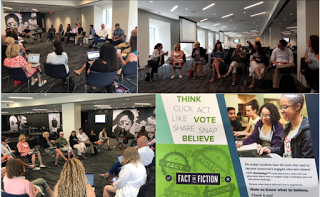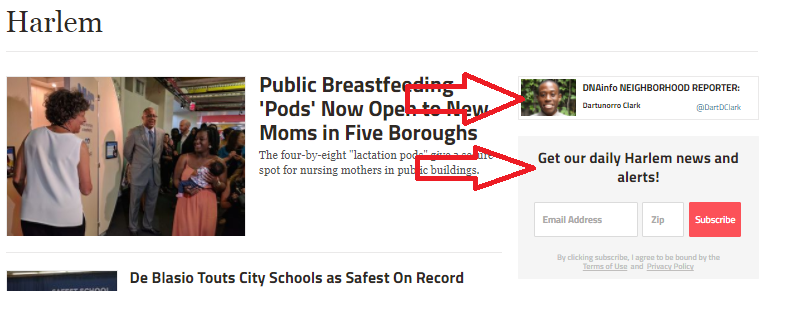7 Strategies to Share Stories of Diverse Communities #NewsLitCamp @TheNewsLP

Participants in breakout sessions at #NewsLitCamp

Most people rarely hear, or read all about the amazing work that inner city students are doing in the local press. That’s because their stories often are not covered by the mainstream media.
Ideas for giving a voice to diverse communities was a topic discussed at the #NewsLitCamp at Time Inc. in New York City.
Damaso Reyes a program manager for The News Literacy Project explains this issue is due in part to the reality that today many of our mainstream newsrooms are not diverse. But educators and their students can help make a shift. Reyes led a discussion on ideas for doing so.
Reyes was drawn to journalism (he worked for many outlets, including Vanity Fair Germany, Time Asia, and Amsterdam News,) because he wanted to share the stories about his own Brooklyn neighborhood. Unfortunately, as an experienced journalist, he learned that, "if it bleeds, it ledes." He wanted to change that and ensure the stories told went beyond the drugs and violence that were commonly covered in the news.
At the #NewsLitCamp we discussed strategies educators can take to uncover the stories of the diverse voices in their school communities.
1) Uncover the issue
Reyes explains that before we can address a problem, we must identify and uncover it. If we want a more diverse representation of voices covered in the press, we need to study what is there currently. Teachers can do this with students by analyzing news outlets looking for patterns in their coverage. Math teachers can help students graph and analyze these patterns to help make a compelling case. Once there is a case for the missing voices, teachers can guide and work with their students to think about what the story is that they want to have heard.
Tools and ideas to transform education. Sign up below.
2) Comment
If there's a story about your community that doesn't provide the whole picture, comment. A teacher can work with her students to draft a well-crafted comment that provides a different perspective.
3) Reach out to reporters
Contact the media outlets with your evidence that points to the lack of coverage in the particular outlet. Suggest the compelling, hidden stories taking place in your school community. You can reach out to reporters via Twitter, phone, email, or even by writing an old fashioned letter. Hitting them via various mediums with multiple voices is often the most effective strategy.
4) Find reporters doing this
Another strategy is to find those stories that are serving your community and figure out and take notice of the reporters or outlets that are covering these stories. Reach out to them to share the story of your students or school community.
5) Develop relationships with those covering local beats
Determine who is covering the local news in your area either via local papers or via reporters who have local beats. Develop a relationship with these people. In New York City a good option is DNA Info. They have local beats with reporters and you can subscribe to their alerts.
Drill down to areas of neighborhoods within boroughs.
See reporters and subscribe to daily alerts.


6) Ethnic and foreign language papers
Is there a large Bangladeshi, West Indian, African American population in your school? Know the papers that cover those cultures. Not sure how to find them or where to start? If you’re in NYC you can visit this listing from Baruch College of the most common and widely distributed ethnic and foreign newspapers in the area.
7) Alert! Alert!
If you find reporters or outlets covering stories that represent diverse voices, sign up for their alerts. Interested in a particular topic, sign up for Google Alerts. Not sure how? Read this from Google support. If they’re on Twitter, Fast Follow em. Here’s how. When you read those stories, engage with the reporters by commenting on the article or Tweeting to them. This will help you to develop relationships.
Do I have your permission?
Let parents know you will be working to celebrate the voices of their children. If you plan to have the student interviewed or will be using their name or work, make sure you get parental consent. Do this at the start of the year in the student’s back-to-school packets. Even having just a few students whose genius you can share can help change the face of the news we are seeing covered in our communities.
These are some of the effective strategies you can try to share the stories of students, staff, and families who are not generally covered by the mainstream media. Maybe there is an idea or two here that will work for you and your students that you can give a try.
Lisa Nielsen writes for and speaks to audiences across the globe about learning innovatively and is frequently covered by local and national media for her views on “Passion (not data) Driven Learning,” "Thinking Outside the Ban" to harness the power of technology for learning, and using the power of social media to provide a voice to educators and students. Ms. Nielsen has worked for more than a decade in various capacities to support learning in real and innovative ways that will prepare students for success. In addition to her award-winning blog, The Innovative Educator, Ms. Nielsen’s writing is featured in places such as Huffington Post, Tech & Learning, ISTE Connects, ASCD Wholechild, MindShift, Leading & Learning, The Unplugged Mom, and is the author the book Teaching Generation Text.
Disclaimer: The information shared here is strictly that of the author and does not reflect the opinions or endorsement of her employer.
Lisa Nielsen (@InnovativeEdu) has worked as a public-school educator and administrator since 1997. She is a prolific writer best known for her award-winning blog, The Innovative Educator. Nielsen is the author of several books and her writing has been featured in media outlets such as The New York Times, The Wall Street Journal, and Tech & Learning.
Disclaimer: The information shared here is strictly that of the author and does not reflect the opinions or endorsement of her employer.
